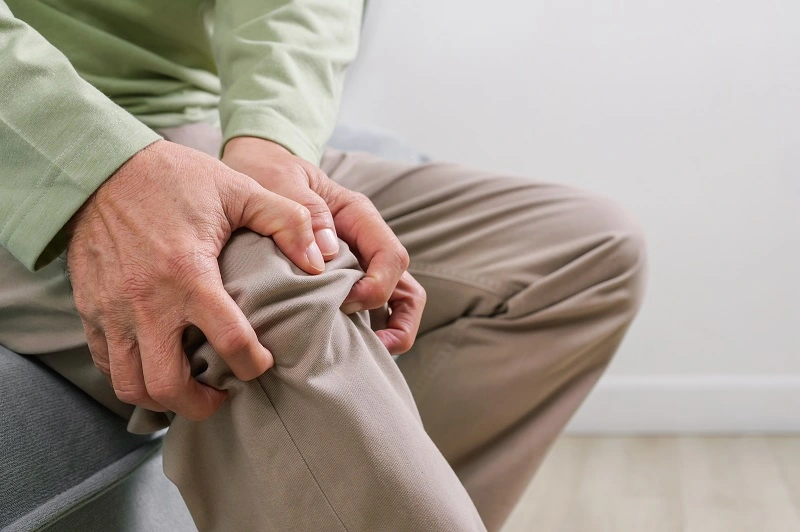General Health
Pseudogout - Causes, Symptoms, & Treatments
Share to

Table of Contents
Pseudogout is a condition of joint inflammation characterized by sudden swelling and pain in one or more joints. This condition can last for days or even weeks. Pseudogout is also known as calcium pyrophosphate dihydrate deposition disease (CPPD). Read more about what pseudogout is in the article below.
What Is Pseudogout?
Calcium pyrophosphate dihydrate deposition disease (CPPD), or pseudogout, is a type of arthritis (joint inflammation) caused by calcium pyrophosphate crystals deposition and marked by swelling and pain in the joints. This condition is commonly found in individuals aged 60 and above (the elderly).
Pseudogout is often confused with gout due to their similar names. However, they have significant differences. Actually, what are the differences between gout and pseudogout? As already explained, pseudogout is caused by the calcium pyrophosphate crystals deposition. Meanwhile, gout arthritis occurs due to the uric acid crystals deposition.
Causes of Pseudogout
Pseudogout occurs when calcium pyrophosphate crystals precipitate and accumulate around the joints. This condition then triggers arthritis, which can result in damage, swelling, or even pain in the joints. It is not yet known for certain why these buildups occur. In fact, some individuals over 85 years old have crystal deposits, but not all of them suffer from pseudogout.
Several factors are suspected to heighten the risk of calcium pyrophosphate crystal deposition in the joints, including:
-
Aged 60 and above (elderly).
-
Experiencing trauma to the joint, such as due to injury or surgery.
-
Genetic disorders.
-
Mineral imbalances in the body. Individuals with excessive calcium and iron levels in their blood or overly low amounts of magnesium are at higher risk of experiencing pseudogout.
-
Other medical conditions, such as hyperthyroidism and hypothyroidism.
-
Joint and bone diseases, such as osteoarthritis, rheumatoid arthritis, and osteoporosis (bone loss).
-
Kidney function disorders, such as kidney failure.
Symptoms of Pseudogout
Pseudogout is a condition that often affects the knees but can also occur in the wrists, elbows, ankles, hips, and shoulders. Some pseudogout symptoms that can arise are as follows:
-
Pain in the joints.
-
Swelling and redness in the joints.
-
The joints feel warm to the touch.
-
Stiffness.
-
Limited joint movement.
-
Fever.
Diagnosing Pseudogout
In the process of establishing a pseudogout diagnosis, the doctor will first conduct a medical interview (anamnesis) about the patient’s symptoms, medical history, and family history. Then, the doctor continues with a thorough physical examination of the patient, especially in the joints, to check for any signs of inflammation.
Subsequently, doctors typically perform a number of supporting examinations to confirm the pseudogout diagnosis. These examinations include:
-
Blood tests to detect thyroid gland problems.
-
Joint fluid aspiration (arthrocentesis) test to detect the calcium pyrophosphate crystals deposition.
-
Imaging tests, such as X-rays, MRI, or joint ultrasound.
How to Treat Pseudogout
In fact, there is no specific medication to manage pseudogout. Nevertheless, considering that the main goal of pseudogout treatment is to relieve pain and improve joint function, doctors typically combine several treatments, including medication administration and joint drainage. Here is the explanation.
-
Medication administration. Several types of medication are typically given to patients with pseudogout, including:
-
NSAIDs (nonsteroidal anti-inflammatory drugs) to relieve pain.
-
Corticosteroids to relieve inflammation.
-
Colchicine to prevent the recurrence of pseudogout symptoms.
-
Joint drainage. This procedure is performed by removing some joint fluid to relieve pain and pressure on the affected joint. This pseudogout treatment is also beneficial for reducing crystal deposition in the joints.
In addition, patients are advised to do self-care at home, such as resting painful joints and applying cold compresses around the joints to reduce inflammation. Patients are also encouraged to exercise regularly and maintain ideal body weight to relax stiff joints and improve movement ability.
Prevention of Pseudogout
Pseudogout is a condition that cannot always be prevented. Upon being diagnosed with pseudogout, some measures that patients can take include regular monitoring and taking medications that the doctor prescribes. Patients are also advised not to overuse the affected joints to prevent the recurrence of the symptoms.
Pseudogout symptoms are similar to some other diseases, such as gout, rheumatoid arthritis, or osteoarthritis. Hence, early examination is necessary to ascertain the cause. This way, patients can receive appropriate treatment.
Therefore, if you experience a number of symptoms indicating pseudogout, such as pain in certain joints, do not hesitate to visit the nearest Siloam Hospitals to get the right diagnosis and treatment from an Internist.
Moreover, even if you do not experience any symptoms, it is essential to maintain bone health by undergoing regular checkups, especially if you are at high risk of bone disorders. In this case, Siloam Hospitals provides a Bone Screening Package that is beneficial for detecting issues with bones, thyroid disorders, kidney diseases, and even side effects of medications.






